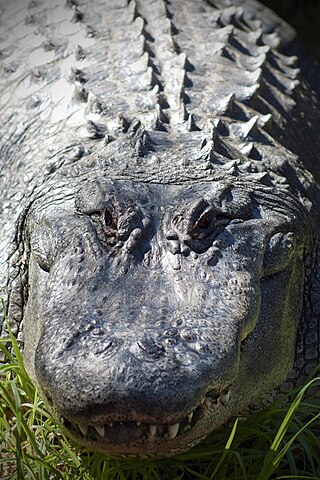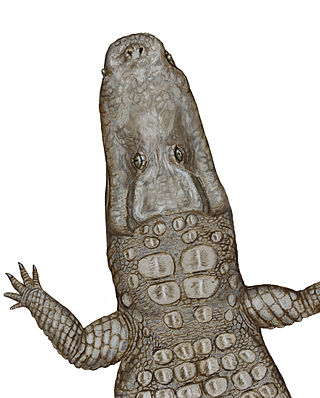
Crocodiles or true crocodiles are large semiaquatic reptiles that live throughout the tropics in Africa, Asia, the Americas and Australia. The term crocodile is sometimes used even more loosely to include all extant members of the order Crocodilia, which includes the alligators and caimans, the gharial and false gharial among other extinct taxa.

Crocodylus is a genus of true crocodiles in the family Crocodylidae.

The dwarf crocodile, also known as the African dwarf crocodile, broad-snouted crocodile or bony crocodile, is an African crocodile that is also the smallest extant (living) species of crocodile.

Mecistops is a genus of crocodiles, the slender-snouted crocodiles, native to sub-Saharan Africa.
Aldabrachampsus is an extinct genus of small horned crocodile known from fragmentary remains. It lived during the Pleistocene on Aldabra Atoll, Seychelles in the western Indian Ocean. The name Aldabrachampsus dilophus means "Two-crested crocodile from Aldabra". It was a small animal, reaching a length of 2–2.5 m, comparable in size to the smallest extant crocodilians.

Euthecodon is an extinct genus of long-snouted crocodile. It was common throughout much of Africa during the Neogene, with fossils being especially common in Kenya, Ethiopia, and Libya. Although superficially resembling that of gharials, the long snout was a trait developed independently from that of other crocodilians and suggests a diet of primarily fish. Euthecodon coexisted with a wide range of other crocodiles in the areas it inhabited before eventually going extinct during the Pleistocene.

Voay is an extinct genus of crocodile from Madagascar that lived during the Late Pleistocene to Holocene, containing only one species, V. robustus. Numerous subfossils have been found, including complete skulls, noted for their distinctive pair of horns on the posterior, as well as vertebrae and osteoderms from such places as Ambolisatra and Antsirabe. The genus is thought to have become extinct relatively recently. It has been suggested to have disappeared in the extinction event that wiped out much of the endemic megafauna on Madagascar, such as the elephant bird and Malagasy hippo, following the arrival of humans to Madagascar around 2000 years ago. Its name comes from the Malagasy word for crocodile.

Crocodyloidea is one of three superfamilies of crocodilians, the other two being Alligatoroidea and Gavialoidea, and it includes the crocodiles. Crocodyloidea may also include the extinct Mekosuchinae, native to Australasia from the Eocene to the Holocene, although this is disputed.
Rimasuchus is an extinct genus of crocodile from the Miocene of Egypt and possibly Libya. Only one species - Rimasuchus lloydi - is currently known. It was previously thought to be a species of Crocodylus, but is now thought to be more closely related to the modern African dwarf crocodiles (Osteolaemus).

Osteolaeminae is a subfamily of true crocodiles within the family Crocodylidae containing the dwarf crocodiles and slender-snouted crocodiles, and is the sister taxon to Crocodylinae.

Brevirostres is a paraphyletic group of crocodilians that included alligatoroids and crocodyloids. Brevirostres are crocodilians with small snouts, and are distinguished from the long-snouted gharials. It is defined phylogenetically as the last common ancestor of Alligator mississippiensis and Crocodylus niloticus and all of its descendants. This classification was based on morphological studies primarily focused on analyzing skeletal traits of living and extinct fossil species, and placed the gharials outside the group due to their unique skull structure, and can be shown in the simplified cladogram below:

"Crocodylus" affinis is an extinct species of crocodyloid from the Eocene of Wyoming. Fossils were first described from the Bridger Formation by American paleontologist Othniel Charles Marsh in 1871. Marsh described the species, along with every other species of crocodyloid in the Bridger Formation, under the genus Crocodylus. The known specimen of "Crocodylus" affinis is a skull found at Grizzly Buttes, Wyoming, measuring 13 inches in length on the upper surface. Recent phylogenetic studies of crocodyloids show that "C." affinis is not a species of Crocodylus, but a genus has not yet been erected to include the species. Other Bridger species such as Crocodylus clavis and Brachyuranochampsa zangerli have been synonymized with "C." affinis.

"Crocodylus" acer is an extinct species of crocodyloid from the Eocene of Utah. A single well preserved skull was described by paleontologist Edward Drinker Cope in 1882 and remains the only known fossil of the species. It was found from the Wasatchian-age Green River Formation. "C." acer had a long, narrow snout and a low, flattened skull.
"Crocodylus" megarhinus is an extinct species of crocodile from the Eocene of Egypt. A partial skull was found by British paleontologist Charles William Andrews in the Fayum Depression. Andrews named Crocodylus megarhinus in 1905 on the basis of the holotype skull. A complete skull was also uncovered from Egypt in 1907 but was not recognized as "C." megarhinus until 1927.
Crocodylus palaeindicus is an extinct species of crocodile from southern Asia. C. palaeindicus lived from the Miocene to the Pliocene. It may be an ancestor of the living Mugger crocodile.

Crocodylus thorbjarnarsoni is an extinct species of crocodile from the Pliocene and Pleistocene of the Turkana Basin in Kenya. It is closely related to the species Crocodylus anthropophagus, which lived during the same time in Tanzania. C. thorbjarnarsoni could be the largest known true crocodile, with the largest skull found indicating a possible total length up to 7.6 m (25 ft). It may have been a predator of early hominins. Crocodylus thorbjarnarsoni was named by Christopher Brochu and Glenn Storrs in 2012 in honor of John Thorbjarnarson, a conservationist who worked to protect endangered crocodilians.

Crocodylus checchiai is an extinct species of crocodile from the Miocene to Pliocene of Libya and Kenya. C. checchiai was named in 1947 based on a skull from the Sahabi Formation. Remains from the lower Nawata Formation in the Turkana Basin of Kenya that were first attributed to the Nile crocodile have now been reassigned to C. checchiai, extending its geographic range. The morphology of the species, in particular the pronounced rostral boss, indicates that it may be the connecting link between African and American species of the genus Crocodylus.
Brochuchus is an extinct genus of crocodile known from the Early Miocene Hiwegi Formation of Rusinga Island in Lake Victoria, Kenya; it was originally named as a species of Crocodylus. It contains two species, B. parvidens and B. pigotti. Brochuchus belongs to the family Crocodylidae, which includes all living crocodiles. The closest living relative of Brochuchus is Osteolaemus, the dwarf crocodile. Compared to Osteolaemus, which has a small body and blunt snout, Brochuchus has a more generalized crocodylid anatomy. Brochuchus is characterized by a flat and relatively narrow skull, and although it is larger than Osteolaemus it is smaller than most other crocodylids. It has two prominent bumps on the surface of its snout.
"Crocodylus" gariepensis is an extinct species of crocodile that lived in southern Africa during the Early Miocene about 17.5 million years ago (Ma). Fossils have been found along a bank of the Orange River in Namibia, near its border with South Africa.

Kinyang is an extinct genus of osteolaemine crocodile from the Early to Middle Miocene of Kenya. Two species are currently known, K. mabokoensis from the Lake Victoria basin and K. tchernovi from the Lake Victoria and Lake Turkana basin. Kinyang had an exceptionally broad and robust skull, much wider than that of any living crocodile species. This might have allowed it to attack and kill prey its own size or even bigger. Kinyang is notably larger than its contemporary relative Brochuchus. While the precise reasons for the extinction of Kinyang are not known, it coincides with a larger faunal turnover that saw osteolaemines replaced by the still dominant crocodylines. One reason for this shift may have been the drying climate of Africa at the time, which caused rainforests to be replaced by more open environments and disrupted the nesting behavior of osteolaemines due to their dependence on foliage.



















